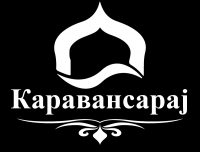JON HASSELL
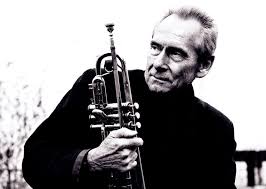
If ever a musician found the bridge between organic and the academic, Jon Hassell has been the quintessential aural engineer. Throughout his eclectic career, the trumpeter has repeatedly shattered the tawdry and facile boundaries surrounding modern modes of music like so much earthen glass, and in process has struggled valiantly in the creation of hybridizations that only recently have been surfacing in contemporary waters.
The wellspring of cultural epochs found so prominently in Hassell’s recorded oevre actually got their start in a minimalist fashion. Hassell studied with a number of the pioneers of electronic minimalism during the late ‘60s, mainly Karlheinz Stockhausen, Terry Riley and LaMonte Young, at a time when minimalist music was still considered to be at the outmost periphery of the avant-garde. The significance of these experiences would not arise until ‘70s, but in meantime, Hassell,s fascination with the building blocks of sound led to his own experiments with microphones and amplifiers; in effect, his entrance into the ambient world had begun. His further involvement with Indian music and singer Pandit Pran Nath inspired him to evolve an entirely new expressive voice through his trumpet, a style of striking immediacy which has become instantly recognizable.
1977’s Vernal Equinox put him on the map. Stark, vivid, it reaped the rewards of both the minimalist school and the classical Indian dialects, but it was painted with a modern, technological latex realized through alternating sounds and naturalist accoutrements.
That position solidified upon the release in 1980 of Possible Musics/Fourth World, Volume One in collaboration with Brian Eno. With its dense yet palpable forests of mysterious, obtuse electronics, ethereal percussions and quavering trumpet, Hassell, along with Eno, had produced a sonorous travelogue of undiscovered regions and intangible lands.
Hassell continued to release records during ‘90s of estimable merit and high regard, shifting his emphasis from the primordial jungles of organia to the polyrhythmic dynamics of seething urban environments.
The simple fact is that had Hassell never tickled our aural fancies, it would have been necessary to invent him. A pivotal musician whose innovative eye and intuitive feel for indigenous musics has led to a synthesis of cultural ethos with technological sound and vision. This is what Hassell has to say about Fourth World Music: ,,The fourth world was an emphasis on the idea that the scales had to be operating at the same time, that there had to be local and global change simultaneously; it was just a matter of balancing it. If you get too ‘global’ then it means ‘coca-colonization’ of everything; if the situation remains too local then you are not in touch with either one.’’
LIFE GARDEN
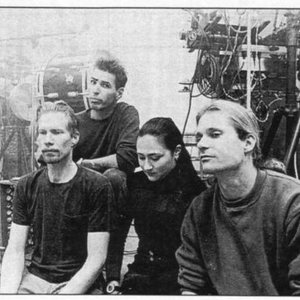
The niche Life Garden occupies is every bit as iconoclastic as the music they play. Straddling a fuzzy line between pseudo-ethnic mysticism and post-industrial gigantism, the foursome that compromise Life Garden wish us to drink of existence heartily, but out of chalice of mystery. Formed in 1990, their first album, Caught Between the Tapestry of Silence and Beauty, largely creates a sensuous, invigorating atmosphere of Tibetan colloquialisms masked in technological dusk. Here the band views the universe with a sense of awe and opulence, laid down atop deep cushions of lush synthesizers and enveloping, sometimes dramatic percussive patterns. Their Pry Open My Mouth with the Red Knife of Heaven is similar in feel to a live Life Garden performance, reflective of a universe in turmoil, opaque and slightly sinister. There is more space between the sounds, as a myriad assortment of ethnic and home-made instruments are prominent in the mix, electronically enhanced. Pry is the more labor-intensive of the two albums, stripped of the existential omniscience, the yin to Tapestry’s yang.
David Oliphant from the band said: ,,Most people that are trained in music are totally flabbergasted by what we do. We worked with a guy who actually had a master’s degree in classical piano and trumpet. In working with him I would say, well, here’s this sound, play with it. And he would say, well in what key? Who the fuck cares what key it’s in? I mean, just make sounds with it, make it work. To me that was mind-boggling because here was somebody who had all these facts in his head, how music ‘worked’ and so on, who wasn’t able to let go of all that and make use of that information. The information itself kept him hidden behind a mask.’’
Other member of the band, Peter Ragan, described their concept: Almost all of our concepts come from playing together live. When we play together we concentrate on dynamics quite a bit, going from very ambient passages very quickly into heavy drumming and industrial noise. That’s one of our strengths, being able to break and run when we want to.’’
Su-Ling Oliphant, David’s wife and also member of the band, summed up: ,,All music is, at some point, based on spirituality, but sounds don’t have to be nice and smooth all the time. Listen to Tibetan music- you have these crashing gongs and slamming sounds. Describing our music I think is best exemplified by that dream, assimilating everything around you and changing it, making it into a new kind of thing. I hate that term new age too, I can’t stand that fucking term. Anything remotely connected to spiritualism is dumped into there, and I think it’s a joke. People can’t just disassociate the music from the concept. You can’t come out and say what you want without some people taking it and running off at some tangent.’’
JEFF GREINKE
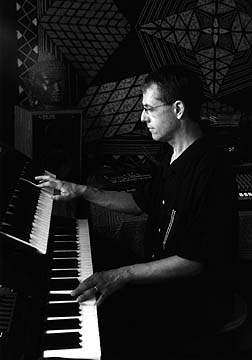
From the desolate, rain-swept moors and blazing dunes of alien cultures, to the petrified forests and fossilized seas of vanished terrestrial epochs, Jeff Greinke explores the undiscovered vistas of imaginary terrain through found sounds, baffling samples, microtonal textures and gamelan-like rhythms. In these grey twilight lands halfway between the primordial and the post-industrial, Greinke’s elegiac vision of alienated urban dwellers still haunted by the lingering shadows of their reptilian past seems strangely appropriate to the ambivalent and disaffected 20th-century ear. His digital triptych, Lost Terrain, Crossing Ngoli and In Another Place, orchestrate at the end of the savage mind, while at the same time excavating the half-remembered tracts and unfamiliar ancestral grounds that lie buried in the streams of human consciousness. Both intimate and inclement, Greinke’s enigmatic realms of light and shadow piece together and merge the conflicting resonances that still echo across the savage interiors of the urban wilderness.Extending the analogy with meteorology, his music seems more concerned with the behavior of phenomena then with the interpretation of ideas or the affectation of moods and feelings. It is possible to view his music as a sort of laboratory experiment, in which the human neurophysical apparatus is stimulated to respond to the aural equivalent of meteorological changes in atmospheric pressure, air density and humidity.
Jeff said that were few turning points in his music life: ,,Meeting Rob Angus changed my life in a dramatic way. Not only did he encourage me to begin making music by accompanying him in the electronic music studio at Penn State, but he also opened me up to a visual and aural world that I had more or less taken for granted prior to our friendship. This heightened awareness began to influence the kind of music I was making and to some extent my approach. When I moved from Pennsylvania to Seattle, I had an experience along the way which had a very striking effect on me. It happened while I was stopped at a little rest spot, a couple miles off the main highway, where the plains join up with the Rockies. I think it was Montana. It was twilight, and the highway was barren except for a lone truck. A drone was produced by the engine of the truck, which caught my attention for its richness and beauty, and it remained that way for what seemed like a long time. Because the truck was moving and because the geography of the mountains was constantly changing. I could hear it subliminally; the change was very, very subtle. This was an important event in my life because it taught me that a single pitch could be of immense interest as long as it was moving. I become very interested in how seemingly static sounds could remain interesting to the listener and how much that depended on how those sounds were processed.’’
STEVE ROACH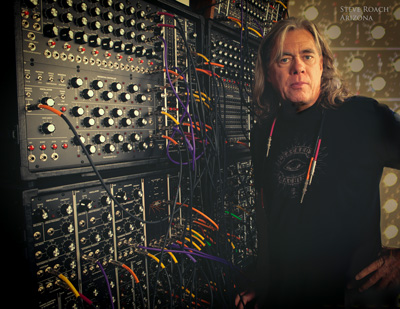
Steve Roach remains one of the most astute practitioners of technological ritualist music on the ever-burgeoning, ever-changing electronic vista. Roach’s music expertly grafts together the numerous tribal paradigms he has so far established, in both collaboration and solo, in such a way that it is impossible not to acknowledge the scope of his primordially-incensed music. It is also difficult not to be moved by the latent power behind his sonic creations, and hence rationalize the inescapable conclusion that amongst his ‘contemporaries’ Roach has few peers. Talking about his masterpiece, which came in collaboration with Mexican musicians Suso Saiz and Jorge Reyes, Steve is pointing out: ,, For me it was very exciting to work on that album for the simple fact that never before have I played so many instruments together beyond synths. Everything from didjeridu, rocks and handpercussions, to string-drums, Indian bellsthat was necessary to create journey backwards and forwards in time. I would not say that electronics have taken any less of a stance in terms of the compositions and their place in the tapestry. At this particular point in my music, exploring and experimenting, seeking new sounds and timbres, the samplers are certainly responsible for introducing acoustic elements into the music, but the fact is that after a while you run off the pavement. You just want to pick instruments up, drawing out the sublety and nuance through something so basic. I felt at home withy all these acoustics in the same way I arrived at that feeling with electronics. Over the years of finding my through the labyrinth of programming and bringing the subtlety into the electronic sounds, working with the acoustic stuff is really a nice breath of fresh air. You can take a lot of the techniques that seem quite daunting at times, and apply them to more direct playing.The combination and the melding of the two was so constant and vital that I can’t really remember where the acoustic ended and the electric began. The accessibility of having all the instruments at my reach is really what it has evolved to, and at the same time wanting to say something that’s timeless and outside of any particular musical trend or influence. Again, it’s being honest to my own musical impulse, like a natural shedding of the skin revealing the new. The intention of what I do and the way I approach it is in that spirit; whatever form the music takes will always evolve and change into unpredictable areas, in terms of whatever life has to offer.’’
PAUL SCHUTZE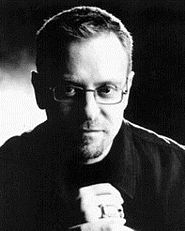
With New Maps of Hell and The Rapture of Metals, Paul Schutze has emerged as an important, ground-breaking musical voice in the progressive electronic arena. Having formal music training in table for only two years, Schutze’s interest in world musics was a strong influence on his work with Laughing Hands back at the beginning of the ‘80s. In mid= 80s, Schutze became involved in scoring films, creating some intriguing, imaginative soundtracks, some of which have had material displayed on Regard: Music By Film. Upset by the sea of mediocrity flooding soundtracks, Schutze has abandoned the idea of scoring any more films. About his record which brought planty of attention, New Maps of Hell, he was very frank: ,,New Maps is an assembly of material covering approximately twelve months work. Some of the parts were written months back then altered, overdubbed, and edited digitally. I had become very interested in long, hypnotic minimal works, in timbrally complex blocks of layered, rhythmic material which are, as Zappa would say, ‘’statistically dense’’ but structurally repetitive, trancy and unchanging. The track ‘’Topology of a Phantom City’’ tries to achive the wonderful sense of what I call ‘chaotic minimalism’, which characterizes much ‘70s fusion experiments, such as Mile Davis Japanise live recordings Agharta, Live Evil and Pangaea, or Herbie Hancock’s Crossing and Head Hunters albums.A particulary good exemple of what I started using as an ‘emotional template’ for ‘’Topology’’ is Love, Love by Julian Priester. This features some deeply wonderful processed trombone playing, which was why I wanted a trombone on the album. The feeling of simultaneous complexity and ‘stasis’, of an infinite snapshot in a wider and disclosed story is very seductive to me. Jon Hassell is my favorite composer/musician and this quality is evident in his work. I listen to his pieces and try to achieve that ‘sense’. Perhaps I don’t trust music which doesn’t hold or compress time for the listener. I am rather fastidious and tend toward the hyper-neat even when I think I’m being random and chaotic. The musicians worked for no fee except a constant smorgasbord of food and wine and we all had an extraordinary week of experimenting and taking the sort of risks that seem reckless when the clock is interfacing directly with your wallet. There is a tendency in some of the ‘ambient’ community to dismiss all urban musics such as rep, techno, funk, thrash, heavy metal, noise and industrial exclusively for the seductions of ambient, world, trance, fusion, new age, minimal, spiritual, etc.T his results in a move from assault and neurosis into an apparently soporific zone of ornament and often passive beauty where exquisite, rarefied, and often bloodless work is seen as an end in itself.’’
STEVE SHEHAN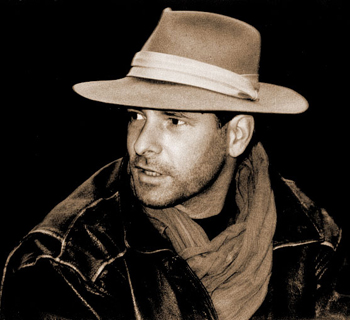
To call Steve Shehan merely a percussionist would not only be a gross understatement, but an act of a critical heresy. With a collection of instruments and images absorbed from a nomad’s searching throughout countries and continents too numerous to annotate, Shehan’s celebratory diatribes accentuate all that is pure, intense and magnetic about so-called world music. It is true that there are still some unfortunate souls who have yet to hear Arrows, Shehan’s wondrous, texturally exotic impression of far-flung worlds within worlds. What makes Arrows so gripping is that Shehan recorded its multi-level tonalities in his small home studio, bringing the girth and metaphorical splashes of landscape with him. Of all the artists redefining the concepts of fourth world music, Shehan’s travels invest his art with towering edifices of honesty and credibility. That the music is as well-traveled and visually arresting as the man is perhaps the best testament to his far-reaching abilities. Imagine how tattered his atlas is…
Rich traveling experiences crossed with extreme musical talent he explains simply and loudly: ,,As a child, I was mostly in blues and rock bands playing electric guitar, then I discovered Coltrane’s A Love Supreme and Bartok’s ‘’Miraculous Mandarin’’ and the magic of Jouie Gilbertos’ bossa nova. My life changed after that. I added a little Weather Report, Stravinsky, Wayne Shorter, Charles Mingus, and put guitar aside to become drummer(under the great influence of Mr. Elvin Jones). I then started travelling around the world and discovered that percussion offered a means to express oneself in any culture. I started working with Cubans and Africans and begun playing professionally. Virtually all music fascinates me, but I was particulary drawn to Indonesian and Afro-Cuban music. I’d say that the music I’m creating today is a reflection of the music that I’ve experienced in the world, including classical music, which I listen to non-stop. My way is one of many ways to promote the interplay between the musical expression of many times and places. All the feedback I’ve received seems positive. People seem to like are stimulated by my music, regardless of their background, culture, ethnic group, profession, economic level, and, most important, their age. Music is the food of love’’
O YUKI CONJUGATE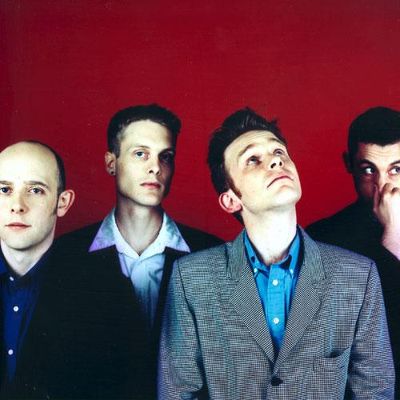
Some of today’s ,,world’’ musicians approach their music in the same traditional manner as the fundamental structures with which they are appropriating, with added embellishment of a synthesizer for color ensuring them a float in the trend parade. Others, like O Yuki Conjugate, take matters into their own hands, corrupting the endless morass of repetition and superficiality by inventing their own trends. O Yuki Conjugate’s music almost defies description and doesn’t begat handy comparisons, because its rich amalgam of ideas is conceived from an experimental iris that doesn’t feel a need to recognize conventional musical applications. Peyote’s narcotic enervations was one of 1991’s more inspired moments, an act of ardent genre tightrope-walking and psychoplasmic ritual that further extended the broad connotations of fourth world music. A quartet of improvisers led by Andrew Hulme, O Yuki Conjugate’s modus operandi is often as mysterious as their name, but with music so idiosyncratic, their residence in a noncategorizable twilight zone serves only to fix attention on the sounds themselves. When describing their music and the music of other artists who exists in the same aural sphere, most reviewers end up using hyphenated adjectives like neotribal, multi-ethnic or pan-cultural. Andrew Hulme is giving his own remarks about their music: ,,Reviewers work with words, they obviously have to try and describe what they are hearing. We work with sounds and do not need to describe it. It just exists, we do not label it; descriptions merely pin things down. I think it is more important to just listen to it rather then talk about it. I do not think we consciously try and produce any effect in the listener. We produce music that we ourselves would want to listen to, because it is what we are interested in. If anyone else gets anything out of it then it is bonus.We worked on our own for such a long time now it seems very strange that we are being attached to other bands or musicians. There is obviously quite an interest in music that combines certain organic and electronic sounds, an idea focused on by Eno and Hassell. I suppose what we do could be called an extension of that. None of us have any musical training. We can not play instruments and we really do not care. What we have is an interest in sound and the manipulation of sound. Conjugate uses a lot of percussion, so we learned how to keep in time with each other, but not with anybody else.
